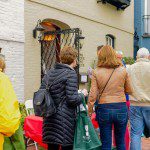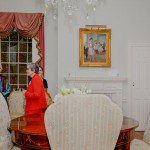Reflecting on ‘This Town’ This Weekend
By • May 11, 2015 0 921

It was a close-to-the-end of April weekend in Washington, spring trying to keep its foothold amid an unseasonable windy chill, and Washington being “This Town” as opposed to “Our Town,” it appeared to be a noticeably more busy weekend than usual.
It’s just a perception, of course. The things that quicken heartbeats in this town are not necessarily the things that can wound hearts, or steady hearts, or make them burst with sudden affection.
In short, it’s the differences between, say, the White House Correspondents Dinner and all of its increasing number of events on the noisy social peripherals of after and before parties and brunches, and the more prosaic annual festivals or celebrations, and routines that add a different sort of more modest jewelry to our daily lives in this, our town.
There is a difference among these occasions—all of them are of course specific to the city we live in, but they offer up different forms of pleasures, excitements and opportunities for reflection.
Let’s be the first to admit that if someone had brought me and dragged me to the WHCD, I would have gone gladly and rented a tux, to boot, and informed everyone I knew about my presence there. That being said, without any sentimentality, going on the Georgetown House Tour, taking in the French Market on Book Hill, picking up the best crab cakes in town at the Dupont Circle farmer’s market on Sunday, the guilty television pleasures “Outlander,” “Madame Secretary” and “Game of Thrones” and watching a beheading on the latter made the weekend fulfilling enough. It did not soften the news and alarms of the weekend news, but it gave them perspective.
I hadn’t been to a house tour in a couple of years or so but I was, step by step, cobble stone by cobble stone, amid all the wandering people, children, dogs and shop keepers and artists and docents and home’s facades, none of them homely, struck by what I missed.
It’s fair to say that Georgetown is unique, or that it is not East of the River, Dupont Circle, Adams Morgan or Petworth, or the Navy Yard. The point is that however affluent or historic, Georgetown, which may be a village, is also a Washington neighborhood, with neighbors. To its residents, and to its many visitors, it is a special place. But then, people who live in Adams Morgan like to think it’s a special place, and it is, in spite of the rapid changes that are coming down and the pop ups that are popping up.
We walked around for about three hours—not non-stop—saw four or five houses along N Street, Prospect Street and P Street, wound our way up and down the 1600 block of Book Hill and the French Market, tasted strong coffee, looked at the expanses of new (to me) stores, noted the changes along antique row with new and impressive art galleries, noted the absence of the Georgetown Restaurant, where 1980s late-night revelers ate breakfast at two in the morning. We ran into old acquaintances not forgotten and were greeted, here and there by readers.
We saw the house were Senator Pell once lived on Prospect Street, with its music room, a piano, a harp standing up, and an inviting kitchen which merged liveably with other functions. We saw the splendid house(s) on N Street where their owners had artfully, and carefully collected paintings, rugs and furniture. A Biedemeier was mentioned at one point. There was a John Marin in one house, and a reading room with a fireplace (working) and a John Grisham book draped over a chair’s arm in another.
It reminded me of tours from the past, the weather then and now—windy, but brightly lit at times—and how once on an afternoon in a house full of Asian statuary, a retired diplomat sipping a cocktail told tales of fireflies gathering on a porch in Bangkok.
We stopped by for the tea at St. John’s Episcopal Church, met the new rector, talked with people from the Senior Center and thought of people long gone and others vibrantly here. We ate one too many cupcakes and then went home, satisfied, past the Ritz Carlton not yet a frozen traffic jam.
I will say that I watched both the President’s speech and “Saturday Night Live” star Cecily Strong’s protracted, equally-opportunity diss of everyone there. I watched it on my computer, not C-Span (meow). The president—who appears to be in his milieu here—killed it—zinging the terrible billionaires for their campaign spending, well, a billion. “I did a little fund raising in my time,” he said. “But I mean my middle name is Hussein.”
Strong, who has that preternatural did-I-say-something-nasty look on her face, did say something nasty, and often. But after a while, between her own reactions, and reaction shots of targets in the crowd, it all seemed like what it was: a kind of familial gathering from opposing families merging into a bigger family. This is “Under The Dome,” Washington-style, featuring not disagreeable townfolk, but politicians and elected officials as celebrities, and celebrities paying to breathe the same air in the room.
How these occasions reference themselves against the urgent dramas of international, national, local and even more familial news and events makes for an interesting contrast.
You would think that a roomful of newsmakers and news reporters would somehow at least be reflective of news. But the great tragedy of Nepal and its natural disaster and the churning rallies, protest and some violence in Baltimore seemed to resonate more in homes and on the street. Surely, that was not the time for the police and race joke by Strong, referencing the president’s abundance of white hair.
The news from the great and/or near world resonates as part of the prosaic and sweet moments, the regularity of regular events made all the more sweeter by the larger world.
Nepal made the front page, the White House Correspondents Dinner got five (page four and a little pages in the Style section with 20 pictures from Saturday night on a Monday pape)r. This Town, maybe not Our Town.
- President Obama at the 2015 White House Correspondents’ Dinner. | Getty Images






